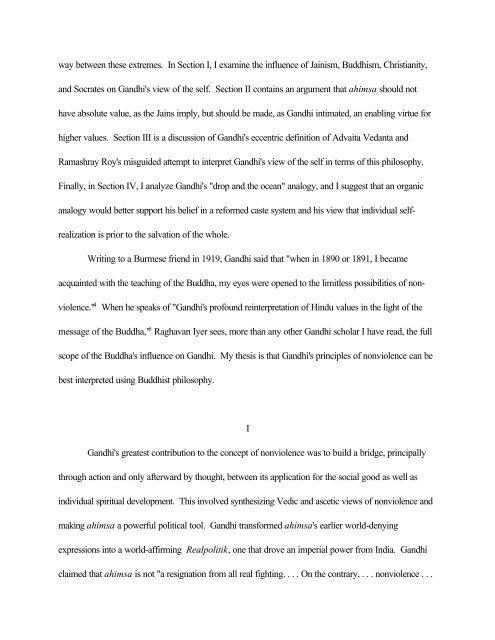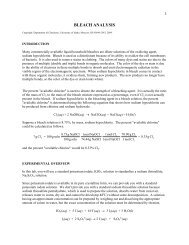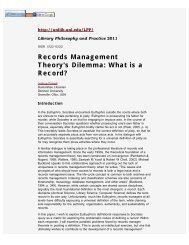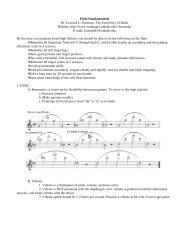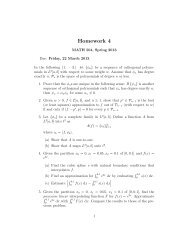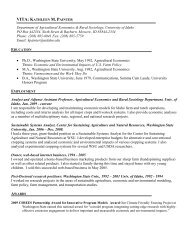Gandhi, Ahimsa, and the Self - University of Idaho
Gandhi, Ahimsa, and the Self - University of Idaho
Gandhi, Ahimsa, and the Self - University of Idaho
You also want an ePaper? Increase the reach of your titles
YUMPU automatically turns print PDFs into web optimized ePapers that Google loves.
way between <strong>the</strong>se extremes. In Section I, I examine <strong>the</strong> influence <strong>of</strong> Jainism, Buddhism, Christianity,<br />
<strong>and</strong> Socrates on <strong>G<strong>and</strong>hi</strong>'s view <strong>of</strong> <strong>the</strong> self. Section II contains an argument that ahimsa should not<br />
have absolute value, as <strong>the</strong> Jains imply, but should be made, as <strong>G<strong>and</strong>hi</strong> intimated, an enabling virtue for<br />
higher values. Section III is a discussion <strong>of</strong> <strong>G<strong>and</strong>hi</strong>'s eccentric definition <strong>of</strong> Advaita Vedanta <strong>and</strong><br />
Ramashray Roy's misguided attempt to interpret <strong>G<strong>and</strong>hi</strong>'s view <strong>of</strong> <strong>the</strong> self in terms <strong>of</strong> this philosophy.<br />
Finally, in Section IV, I analyze <strong>G<strong>and</strong>hi</strong>'s "drop <strong>and</strong> <strong>the</strong> ocean" analogy, <strong>and</strong> I suggest that an organic<br />
analogy would better support his belief in a reformed caste system <strong>and</strong> his view that individual self-<br />
realization is prior to <strong>the</strong> salvation <strong>of</strong> <strong>the</strong> whole.<br />
Writing to a Burmese friend in 1919, <strong>G<strong>and</strong>hi</strong> said that "when in 1890 or 1891, I became<br />
acquainted with <strong>the</strong> teaching <strong>of</strong> <strong>the</strong> Buddha, my eyes were opened to <strong>the</strong> limitless possibilities <strong>of</strong> non-<br />
violence." 4 When he speaks <strong>of</strong> "<strong>G<strong>and</strong>hi</strong>'s pr<strong>of</strong>ound reinterpretation <strong>of</strong> Hindu values in <strong>the</strong> light <strong>of</strong> <strong>the</strong><br />
message <strong>of</strong> <strong>the</strong> Buddha," 5 Raghavan Iyer sees, more than any o<strong>the</strong>r <strong>G<strong>and</strong>hi</strong> scholar I have read, <strong>the</strong> full<br />
scope <strong>of</strong> <strong>the</strong> Buddha's influence on <strong>G<strong>and</strong>hi</strong>. My <strong>the</strong>sis is that <strong>G<strong>and</strong>hi</strong>'s principles <strong>of</strong> nonviolence can be<br />
best interpreted using Buddhist philosophy.<br />
I<br />
<strong>G<strong>and</strong>hi</strong>'s greatest contribution to <strong>the</strong> concept <strong>of</strong> nonviolence was to build a bridge, principally<br />
through action <strong>and</strong> only afterward by thought, between its application for <strong>the</strong> social good as well as<br />
individual spiritual development. This involved syn<strong>the</strong>sizing Vedic <strong>and</strong> ascetic views <strong>of</strong> nonviolence <strong>and</strong><br />
making ahimsa a powerful political tool. <strong>G<strong>and</strong>hi</strong> transformed ahimsa's earlier world-denying<br />
expressions into a world-affirming Realpolitik, one that drove an imperial power from India. <strong>G<strong>and</strong>hi</strong><br />
claimed that ahimsa is not "a resignation from all real fighting. . . . On <strong>the</strong> contrary, . . . nonviolence . . .


